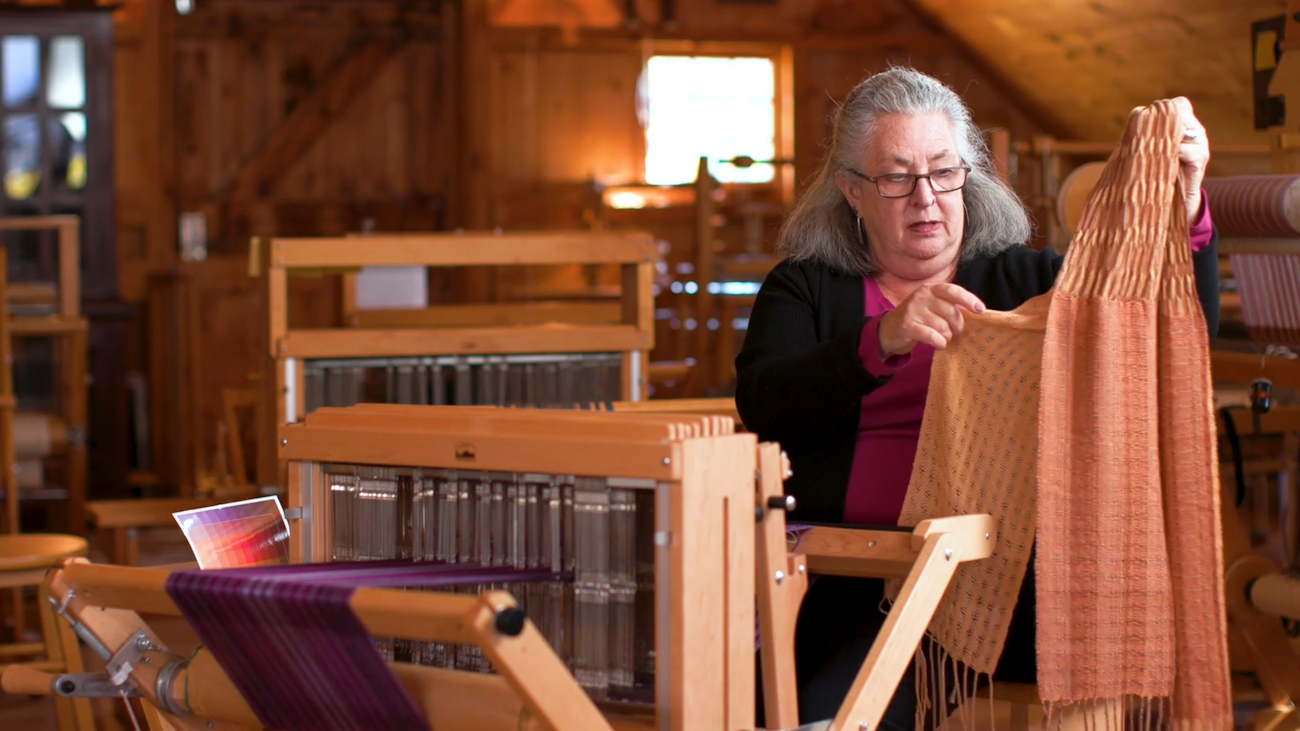When I started watching “Experiments in Deflected Doubleweave,” I was expecting to be blown away by super-techy weave structure stuff that would make my head spin. I was so wrong. Instead, I was blown away by really beautiful weaving and inspirational new ways to adapt deflected doubleweave (DDW) to different techniques. Janney Simpson, the instructor, is very creative and one of those hard-working weavers who is continually trying new things in weaving, and in her case, that means pushing the DDW envelope.
Crimp Weave
 Crimp weave with layers: Looking for a unique scarf to weave and wear? Here’s one with layers on both ends and a crimp-weave center.
Crimp weave with layers: Looking for a unique scarf to weave and wear? Here’s one with layers on both ends and a crimp-weave center.
You probably already know about crimp weave, the style of weaving, developed by Diane Totten, that creates permanent pleats in fabric. Did you know you could do it with DDW? Janney shows how you can weave a scarf with crimp weave in the neck area and layers of cloth on either end for a dramatic look.
Weaving Layers of DDW with Fine Threads
 Fine silk threads create a checkerboard of pattern and negative space.
Fine silk threads create a checkerboard of pattern and negative space.
Most of the pieces Janney weaves in the video are a mixture of Zephyr wool/silk and Tencel but she doesn’t shy away from using silk, including fine silk such as 60/2 silk. She weaves the silk into a grid of plain weave and spaces creating what resembles a fine screen. It’s breathtaking!
Clasped Weft
 Clasped weft adds yet more color play to DDW.
Clasped weft adds yet more color play to DDW.
I believe most of us think of clasped weft as something you can add to plain weave, but Janney incorporates it into a DDW piece. She demonstrates two ways of clasping weft, drawing both wefts into the same shed for double picks or bringing the shuttles out of the warp, changing the shed, and then clasping the wefts before putting them back into the new shed.
V-Shaped Shawls
 Warp ends become weft when weaving a V-shaped shawl.
Warp ends become weft when weaving a V-shaped shawl.
Intellectually you know how to weave a V-shaped shawl, but you may not have tried it or seen the technique in action. Watching Janney weave the center corner pick-by-pick is interesting. As she works, she talks and gives tips for a good result. I’ve seen V-shaped shawls woven in plaids but the patterning in her DDW shawls is spectacular. Check out the one on the left in the photo at top.
More Layers!
 You may not want to wear this around toddlers and pets, but the layers are like gossamer.
You may not want to wear this around toddlers and pets, but the layers are like gossamer.
Just in case two layers aren’t enough, how about three or four? This part isn’t for 8 shafts but more like 16 shafts. Janney dips into the subject showing how the layers separate and demonstrates weaving multiple layers and how to stabilize them with wet-finishing. She does note that the layers may not all be super-sturdy, but that isn’t necessarily a reason not to try it!
There is much more in this course, including fun stuff such as adding beads to fringe, but there are also more technical parts about how to design and weave your own pieces with yarn and sett recommendations and steps and drafts to follow. Whatever technique you want to learn more about, whether it is weave-structure-based or more esoteric, I think you’ll agree with me that watching an experienced and imaginative weaver at her loom is, in and of itself, inspirational.
Weave well,
Susan

